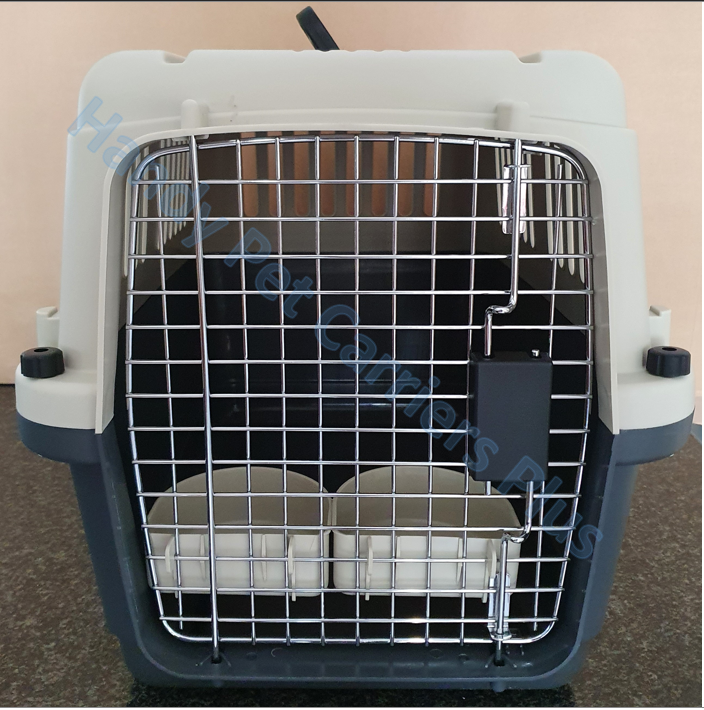Dog and Cat Travel Crates Tips
 CRATE TRAINING TIPS.
CRATE TRAINING TIPS.
First, of course, you need a crate.
Second, you need a nice thick, cosy, comfortable blanket to place inside the crate. In the heat of summer a nice cool sheet over the blanket will add to the dogs comfort.

Select a good location for the crate. Your bedroom or en-suite bathroom is good at night, but while you are home during the day, it is best to have the crate near where people will be. Move the crate around to wherever you are. Don’t put the crate where sunlight will come through a window as it will make the air hot for the dog and make his crate experience unpleasant.
Tie the door open, or you could even remove the door completely, but remember to tighten the nuts to secure the body of the crate. Let the dog notice the crate and examine it if he wishes.
Bit by bit, make it more interesting. Throw toys or treats in. Talk lovingly to him if he goes in. Make a fuss of him while he is in the crate.
Begin feeding the dog in the crate. When he is comfortable going in (and this can be anything from an hour to a few days), then begin closing the door for very short periods while you are right there.
If he whines to get out, don’t let him out and don’t sweet-talk him until there is a moment when he isn’t whining. Just wait until he is quiet, then you can let him out and let him know that he is a good fellow. If you let him out while he is whining, you are teaching him that whining works with you.
With each of the steps, pay close attention to the dog’s reactions. Crate training is most effective when it isn’t rushed. If he is uncomfortable at a particular step, back up to a previous one. Don’t become impatient.
Once he accepts the door closed while you are there, begin going elsewhere in your home and gradually lengthening the time you are gone. Having safe toys in the crate is useful and they will keep him occupied.

If all going well, leave the house for a very short time, hang the washing out or go for a stroll in the garden and come back to check up on him. Eventually, you will be able to leave him in the crate for longer periods, without him becoming anxious.
Close the dog in at bedtime and let him out first thing in the morning. But once the dog behaves without being locked in at night, leave the door open or remove it from the crate (unless you are using it during the day) and keep it nearby.
Puppy crate training is a fantastic method of managing the safety and well-being of young puppies. When used properly the crate is an invaluable tool for establishing good habits in your puppies and also for preventing problem behavior before they arise.
In spite of what you may think or have read about puppy crate training the truth is that we crate train our puppies for their benefit – that’s why we do it. Secondary to that is the fact that using a crate also benefits us and our furniture, shoes, carpet, cushions, cell phones, reading glasses, USB memory sticks etc…
Your puppy’s first impression and experiences with the crate are all important. You need to ensure that your puppy views the crate as a positive object right from the start. Your goal is for your puppy to love the crate and choose to use it himself.
Good luck.
 CHECKLIST TO KEEP THE STRESS LEVEL DOWN.
CHECKLIST TO KEEP THE STRESS LEVEL DOWN.
Have an airline compliant crate (IATA) and be sure that your dog thinks of it as a den. To get the pet comfortable with the crate, try taking your pet on short road trips in the carrier. Read the Crate Training tips.
Outfit the crate, put a nice cozy blanket inside for the comfort of the dog, even maybe a couple of soft, “doggy” safe toys.
Check the flight time and book a direct fight if possible to avoid plane changes. Take into consideration that your pet may be in the crate for six hours or longer depending on the destination.
Ask the airline regarding the food bowl and water bowl requirements. You might need to purchase little plastic bowls for the food and/ or water. These plastic bowls can be secured to the metal door with cable ties. You might have to make a few holes in the containers for the cable ties to fit through.
Check the airline policies regarding booking-in time at the airport, kennel requirements, veterinarian records, costs and weight limits. There may be more requirements for different airlines.

Get a Health Certificate from your veterinarian for your dog to fly. A pet cannot fly without records stating that the animal is in good health. Most airlines require those documents to be no more than 30 days old.
On flight day, it’s a good idea to feed your dog four to six hours prior to departure. Give your pooch minimal water to avoid full bladders.
Find a way to exercise your dog before the flight. Check with the airport to see if there is a dog-run area.
Secure the crate door to the air vents on the side of the crate with cable ties, (for the small crates) to ensure security of your pet. For the larger sizes there are designated holes for the cable ties – 2 above the gate and 2 below the gate – for added security.
Do not sedate your pet. Sedation could lead to injury if your dog’s crate moves during the flight and your pet can’t react to it. Also, try to stay relaxed because your pet can sense your tension.
